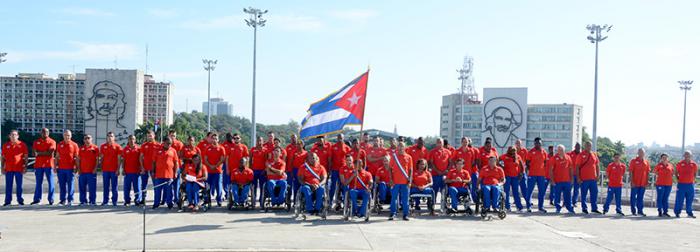
Efficiency and determination marked the performances of Cuban athletes in the recently held VI Para Pan American Games, with the national team placing seventh and wining a total of 13 gold medals, 10 silver, and 16 bronze.
Beyond the statistics, what was most decisive was the effort of the 46 athletes intent upon “Going for more.” While they did not surpass the number of medals won in Toronto 2015, they were able to deliver a very efficient performance, winning medals in a high percentage of the events in which they participated, 84.8%.
During these Games, Cuban athletes competed in only 67 of the 370 events, 18%.
Yet 33 of the team members won at least one medal, 71.7%.
Among the milestones of these Games were the three gold medals won by runner Omara Durand in the 100, 200, and 400 meter races in the T12 category (visually impaired), who thus proved herself as a worthy team captain.
Another athlete to capture a trio of medals was swimmer Lorenzo Pérez, with a gold in the 400 meters free style S6, and silver in the 50 and 100 meters, despite not arriving in optimal condition, following a bout with dengue just before the event.
No less impressive was the debut of Yenigladys Suarez, with gold and bronze medals in the 10-meter air gun and 25-meter SH1, respectively, among the leading multi-medalists. She was left without a medal in the 50 meters when her well-worn gun jammed, but was able to bounce back.
Suarez was among the 20 Cuban rookies competing in these Games, although judoka Jorge Hierrezuelo, 2012 London Paralympic champion, had his functional-medical classification revoked, as did taekwondoka Arlettys Martínez.
Very important victories were won by Yunier Fernández in table tennis, already in his fourth Games, always in the first two spots in the TT1 category (wheelchair), as well as those in the javelin event, including Ulicer Aguilera (F13- visually impaired), Guillermo Varona (F46-affected upper limbs) and Gerdan Fonseca (F43-64-prosthesis in lower limbs), who is one of the few active participants to have competed in all six Para Pan Americans since Mexico City 1999.
Weightlifter Leidy Rodríguez (41-45 kg), judoka Yordanis Fernández (now in +100 kg) and long jumper Luis Felipe Gutierrez (T13), who all revalidated their titles, were among the experienced athletes to attend again this year, although others who won medals in Toronto were sorely missed.
Not only gold medalists deserve applause. Swimmer Juan Castillo won a silver with a good time in the 100 meter butterfly S10, that would have been gold in the S9 category, which he won in Canada. Taekwondoka Adrián García in the 75-kg K44 (upper limbs affected) put in a series of excellent performances before falling to Mexican world champion Juan García.
A case that attracted attention was that of Leonardo Díaz in the discus throw F56-57 (seated) when he was stripped of his silver medal by an arbitration panel on the basis of a video recorded by members of the Mexican team, without viewing the official one, to the chagrin of the Paralympics champion and nine-time world record holder.
Nor can it be forgotten that three of Oniger Drake’s attempts at lifting 204 kg were invalidated, although he recently finished fourth in the World Championship in Nur Sultan, Kazakhstan, with 208 kg.
Cuba’s athletes delivered a great effort to secure victories, and deserve the recognition of their people, always present for their competitions and to whom so many medals were dedicated.
Lima was, no doubt, a successful chapter in the history of Cuban athletes with disabilities.






